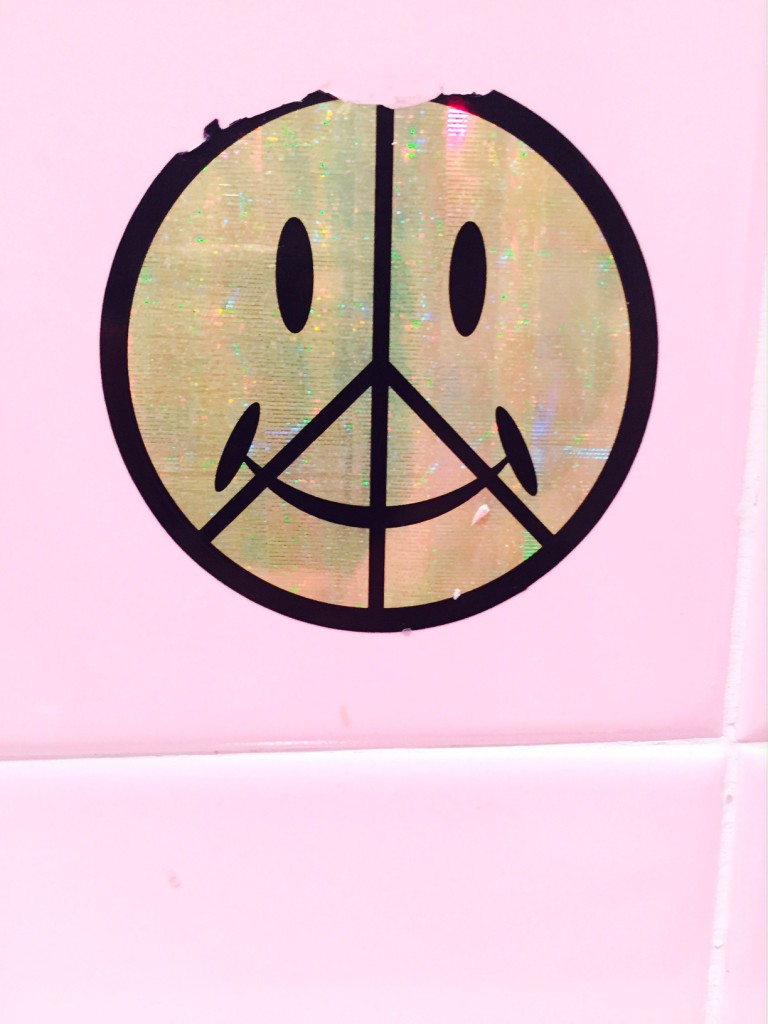When I was twelve years old, I remember seeing it: my first smiley face. It was gigantic and bright yellow, hanging on the exterior brick wall of a car dealership, located on a busy street in Evanston, Illinois, a suburb just north of Chicago.
I hated that smiley face. Seeing its mouth forever turned into an elongated, stretched-out curved line, I thought of my teachers who told me to “turn that frown upside down.” I thought to myself, “Maybe I want to be sad,” wishing that they could hear my thoughts. Being happy just seemed lame, uncomplicated, and dumb. I thought of that Garbage song that I loved to listen to on the bus ride home from Haven Middle School. The chorus line blared: “I’m only happy when it rains, I’m only happy when it’s complicated.” I could relate to those thoughts. At school, I mirrored the opposite of that smiley face. I pledged to be happy only if I could still be interesting. For some reason while I was a teenager, the two seemed mutually exclusive to me.
My middle-school best friend Eleanor and I would sneak out in the middle of the night, go to the car dealership, spray-paint a moustache, sad face, and teeth onto the smiley face, and then run back to her house—our “fuck you” to that saccharine symbol of happiness. The owners of the dealership never caught us, but they did paint yellow over our black graffiti, multiple times. The smiley face was their business logo, and they needed to keep it happy.
Eventually Eleanor and I graduated from middle school, went to high school, and stopped walking past that smiley face. We didn’t even feel compelled to deface it anymore. We accepted it for what it was—a symbol of corporate, forced happiness—created in 1963 by an advertising man named Harvey Ball for State Mutual Life Assurance Company’s internal PR campaign. This smiley face was meant to improve morale after recent job losses, which were the result of the merger between State Mutual and Ohio’s Guarantee Mutual Company. It would take them to new heights, turning everyone’s frowns upside down!
Perhaps the inherently corporate nature of this symbol’s history is part of the reason it is consistently mocked or deconstructed by artists and writers. Besides, how many artists are actually happy all the time? Making art is an emotional endeavor, and many artists are socially anxious, somewhat depressed, highly sensitive, and tend to be loners. But no artist will deny that there is happiness in the art-making process, in excavating past teen memories for comedic purposes, and in just letting the creative forces that be go out into the world and become whatever they’re supposed to be. Happiness is possible—perhaps not all the time but sometimes and maybe even often. Art doesn’t need to reflect any type of happiness; in fact, it usually does not. But inner happiness is possible; often, it has nothing to do with writing or making art but everything to do with gratitude: recognizing the privilege of being able to pursue creative projects and to be alive today.
I’m quite excited — but not necessarily happy — to serve as the guest editor of the September/October 2015 issue of ART21 Magazine, which considers meanings of happiness in contemporary art, technology, and visual culture. The articles, essays, and interviews in this issue present a healthy mix of ideas that relate to happiness.
Eve Peyser examines the correlation between depression, creativity, and intelligence, using texts such as Prozac Nation. In doing so, she takes down the tortured-artist myth and outlines a personal, tongue-in-cheek guidebook for making a happy artist.
Rob Horning looks at Tender, the Tinder meat-swiper art project, as a launching point for discussing the automation of dating practices and the assumptions about happiness that they present.
Faith Holland writes about taking breaks from social media, and the related fear of missing out (FOMO), offering relief in the form of Internet cats and considering happiness as a by-product of cat-oriented distraction from work.
Alexis Anais Avedisian considers the ways that access to archived digital memories and Internet relationships can be sources of happiness.
Corinna Kirsch’s essay looks at the current trend in art of pursuing happiness toward self-betterment, including online self-help and personal tutorials, asking if this is what guides artists to some semblance of happiness.
Svetlana Kitto’s essay looks at the misleading yet sincere cover art of books by the complicated contemporary author Elena Ferrante, relating these images to historical idealizations of motherhood and female friendship.
Alex Huntsberger takes examples from Chicago theater performances to consider how the theatrical tradition, dating back to the Greeks, has little interest in happiness but instead cherishes the moment of catharsis.
Jackie Gleisner visits with Saya Woolfalk at her Manhattan studio to discuss the social construction of happiness that the artist explores in a recent exhibition at the Seattle Museum of Art.
The Los Angeles artist Erik Benjamins offers philosophical meanderings about his experience this past summer at the Santa Fe International Folk Museum. He wonders if the blissful, almost melodramatic spiritual experience is a slow route that can lead to a grateful happiness.
Whatever your route to self-enlightenment, satisfaction, or redemption—welcome to the “Happiness” issue!
Yours,
Alicia Eler





